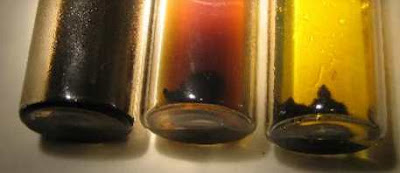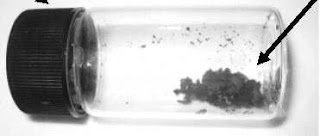Funny that this simple test has been the source of a lot of consternation, much of which will have to wait for a more thorough re-telling. Suffice it to say, that my colleague, who will want to remain anonymous, and I knew the importance of finding a repeatable field test. We found out about the time of Austin passing its sealant ban, that there was no easy way to figure this out published.
After some trial and error, we have come up with a pretty reliable and definitely cheap test. The USGS successfully used this on the Indoor Dust Study (2010) to differentiate between coal tar sealed and asphalt sealed parking lots.
Although we invented the process and have a patent-pending from the US Patent Office, we have never hesitated to share the technique with anyone. Without going into a lot of legalese, we have elected to make this test available to the public for no charge. It is in the public domain and no one can have exclusive rights to it.
This is not, yet, an official test following a standard protocol. It should be used as a screening test and the user takes on any and all responsibility for its use. In the City of Austin, it is used as a first screening tool, but for legal enforcement laboratory tests are employed.
Supplies needed for a field test of parking lot sealant:
- nitrile, rubber or neoprene gloves-1 pair per test
- goggles or safety glasses
- a water tight jar and lid (one per test)
- paint thinner -an ounce or so per test, add enough to generously immerse the dry sealant
- single edged razor blade or straight edge. A flat head screwdriver works just fine.
- disposable cleaning wipes
- cat litter to dispose of the test sample
Paint thinner and mineral spirits are kind of a generic term for a variety of solvents. Some of these give mixed results. What works best is referred to as a “Stoddard solvent” in the ingredients or the MSDS sheet as shown below. At this time Home Depot is one of those hardware stores that gives a direct link to the MSDS sheets from the product website. It isn’t so easy with others.

Prior to acquiring sample-put on gloves to protect hands from possible contamination. As best as I understand it, the natural oil in your skin activates the nasty chemicals and can cause them to be absorbed into your blood stream.
Determine the use of the sample. This will dictate the method for sampling. If it is to enforce a ban, you must find a place to sample the top layer only. Sometimes parking lots have multiple layers of old sealant, but the trick is to find a place where only the new sealant is or where there is some separation between layers. A layer is only about as thick as a thin slice of cheese, but it can be thicker or thinner in spots.
If the use of the test is just to determine the presence or absence of a coal tar sealant, then the sampling does not need to be so careful. Just scrape a bit until you have about a pea-sized quantity of material and place it in the glass container.
In either case scrape the surface in area where the application is typically thickest-along the edges or imperfections in the asphalt surface. Contractors typically brush or broom the edges by hand. It works best if you angle your blade or screw driver at about a 45 degree angle. Be care not to pry the sealant with the blade because you might break off a corner of the blade and it might end up in your eye (but not if you have your safety glasses on!)
Add enough paint thinner to submerge the sample and tighten the lid. I prefer to reuse the blades by carefully wiping them off with a disposable wipe.
Sometimes it helps to gently swirl the solution for a minute or two. By 10 minutes at room temperature or higher, the liquid will take on 3 possible color changes. I have done this test successfully on a black snow pile scraped from a coal tar sealed parking lot, but I let it sit overnight. The first photo shows the color change. You can see why the USGS researchers call this a “coffee/tea test”. The vial on the left is primarily dissolved and is “coffee” in appearance; therefore it is an asphalt sealant. The middle and right vials are more “tea” like and show the colors being pulled out of the coal tar sealant. The middle vial is most likely a blend of the two and we typically see this as a reddish color.
The real trick of the test is that asphalt sealants generally dissolve in paint thinner and while coal tar sealants don’t dissolve, they cause a color change. Much of the coal tar sealant does not dissolve. The results remain fairly constant over time.
According to the State of New York, left over solvents like this should be disposed of in the following manner:
According to the State of New York, left over solvents like this should be disposed of in the following manner:
If the solvents must be disposed immediately, then very small amounts (less than one cup) of nonhalogenated solvents can be evaporated by mixing the solvent with an absorbent and leaving the solvent mixture outdoors. When the absorbent is fully dried, it should be wrapped in a plastic bag and placed with other trash. This should be done carefully so that children or animals cannot come into contact with the chemical. Always ensure proper ventilation when evaporating solvents.Let me know how this works for you.




